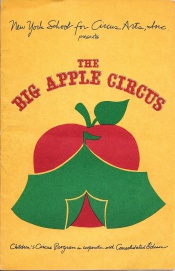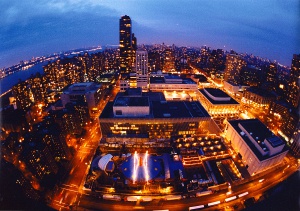Big Apple Circus
From Circopedia
By Dominique Jando
From Paris To New York
The brainchild of Paul Binder, the Big Apple Circus was created by Paul Binder and Michael Christensen in 1977. It was originally the performing arm of the New York School for Circus Arts, Inc., which was its non-profit parent organization. (As a result of the circus's increasing success and broad name recognition, the organization changed its name to Big Apple Circus Ltd. in 1988.) The idea of creating a circus school and a one-ring, European-style circus in New York City had stemmed from Binder's and Christensen's experience at Annie Fratellini's Nouveau Cirque de Paris, in France, where they had performed their comedy juggling act in 1975.Then and there, they fell in love with the circus—the circus in its original concept, that is, intimate, artistic, theatrical, as opposed to the three-ring, ultra-commercialized affair it had become in the United States. Binder thought that such a human-scale circus, where the performers' artistry was more important than the production's razzmatazz and glitz, should have a place in his hometown. He found the people to implement his ideas, chiefly among whom Alan B. Slifka (1929-2011), a successful investment banker and New York philanthropist, who became the circus' founding chairman.
The Big Apple Circus gave its first performance July 18, 1977, under a small, green canvas big topThe circus tent. America: The main tent of a traveling circus, where the show is performed, as opposed to the other tops. (French, Russian: Chapiteau) planted in the shadow of the World Trade Center, on a Manhattan landfill that was to become Battery Park City. The New York press and the New Yorkers loved it: "For 90 minutes, New York turns into a village on fair day, binding adults and children alike in a community of sheer pleasure," said the New York Post. The beginnings were modest, however—and difficult. For its second season, in the summer of 1978, the circus put its tent on the vacant lot of the old Madison Square Garden, on Eighth Avenue. But in 1979, it didn't have the financial means to support another season. At that point, it was go or bust.
The Big Apple Circus At Lincoln Center
The New York School for Circus Arts reorganized itself, and in the summer of 1980, the Big Apple Circusd resurfaced in Brooklyn. Meanwhile, its new Executive Director, Judith Friedlaender, struck what was, for the Circus, the "deal of the century." On December 4, 1981, it gave its first Holiday Season performance under a brand-new, Italian big topThe circus tent. America: The main tent of a traveling circus, where the show is performed, as opposed to the other tops. (French, Russian: Chapiteau) in Damrosch Park, tucked between the Metropolitan Opera and the New York State Theatre at the heart of Lincoln Center—the cultural center of New York and the United States. The show featured an all-star circus cast, including wirewalker Philippe Petit, the Flying Gaonas, and equestrienneA female equestrian, or horse trainer, horse presenter, or acrobat on horseback. Katja Schumann. The "little circus that could" had hit the Big Time. In 1983, it received an OBIE award for "Outstanding Achievement in the Theater."
The Big Apple Circus's Holiday Season at Lincoln Center has since become a New York's cherished tradition. The circus has also expanded its reach, first touring New York's five boroughs in the spring and summer, then exploring new territories: Boston, where the circus went for the first time in June of 1985 for a show with the Boston Pops Orchestra, became its second home. Today, the Big Apple Circus tours under a state-of-the-art big topThe circus tent. America: The main tent of a traveling circus, where the show is performed, as opposed to the other tops. (French, Russian: Chapiteau) for a nine-month season that can take it as far as Atlanta, Georgia, in the South; Buffalo, New York, in the North; and Chicago, Illinois, in the west.Although its performers come from all around the planet, the Big Apple Circus has developed over the years a very distinctive style. It has an unmistakable New York energy. Its shows are built around a theme, renewed each year: Different story, different costumes, set, music, lighting, and different show directors, choreographers, designers, etc. Each production is built like a Broadway show, a necessity since it has to compete, during the Holiday Season, with the many offerings of the Great White Way and other Christmas spectaculars!
Still a non-profit organization, the Big Apple Circus runs community outreach programs such as the Big Apple Circus Clown Care®, which provides children with much needed entertainment, laughter and silliness in top pediatric hospitals all over the country. Thanks to its founders, but also to a string of talented Executive Directors over the years (Judith Friedlaender, Elizabeth I. McCann, James C. McIntyre, Gary Dunning), the Big Apple Circus is considered today as one of the most successful non-profit performing arts organizations in the U.S., and one of the world's leading circuses.
Image Gallery
- BAC 1983.jpg
Big Apple Circus (1983)
External links
Big Apple Circus (www.bigapplecircus.org)
Suggested reading
- Peter Angelo Simon, Big Apple Circus (New York, Penguin Books, 1978)
- Hana Machotka, The Magic Ring: A Year With The Big Apple Circus (New York, William Morrow & Company, 1988) ISBN 0-688-07449-9
- Diana Starr Cooper, Night After Night (Washington DC/Covelo CA, Island Press/Shearwater Books, 1994) ISBN 1-559-63306-9
- Dominique Jando, Big Apple Circus: 25 Years (New York, Big Apple Circus in collaboration with Odyssey Guides, 2003) ISBN 962-217-724-7













